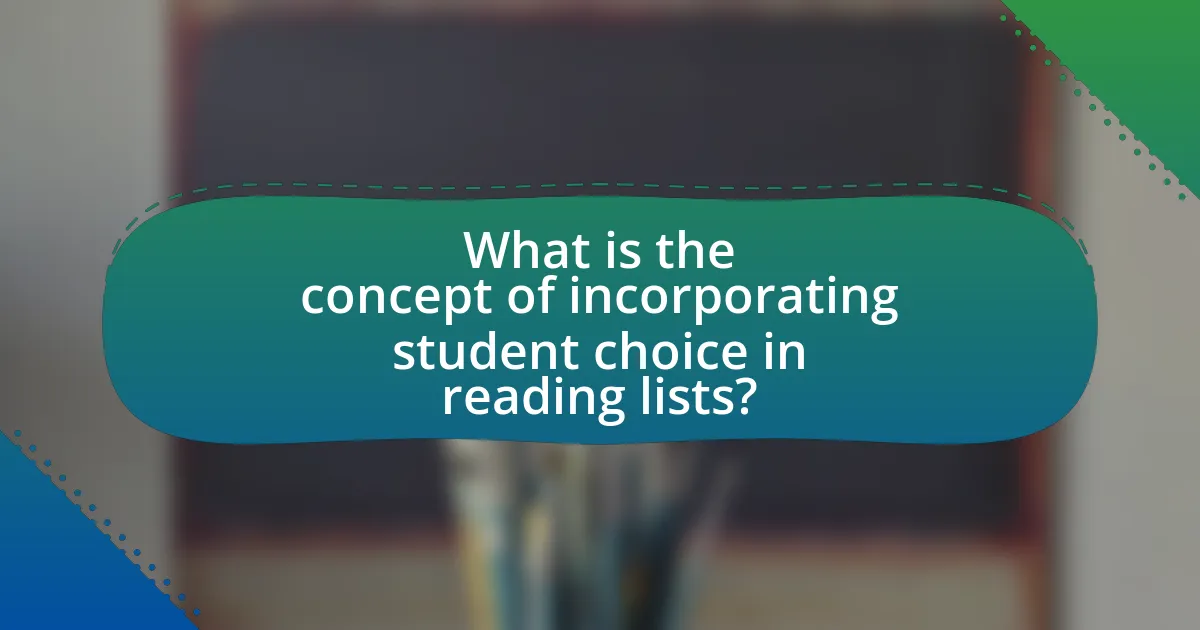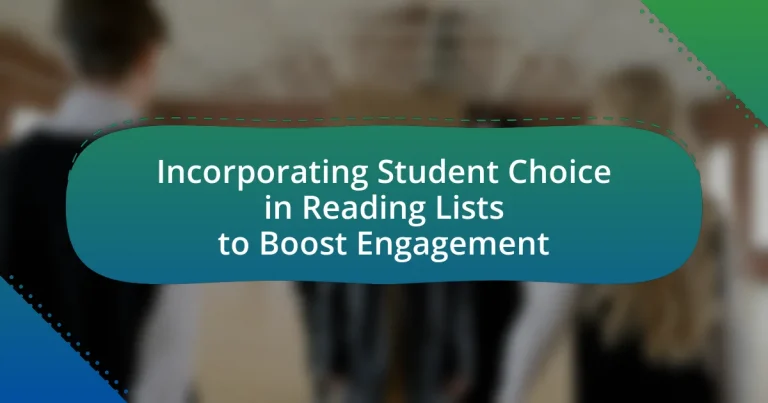The article focuses on the concept of incorporating student choice in reading lists to enhance engagement and motivation among learners. It highlights the importance of allowing students to select their reading materials, which fosters a sense of ownership and leads to improved comprehension and retention. Key components of effective reading lists include diverse genres, relevance to student interests, and appropriate difficulty levels. The article also discusses strategies for educators to implement student choice, the psychological benefits of autonomy in learning, and the potential challenges that may arise, emphasizing the positive impact of personalized reading experiences on educational outcomes.

What is the concept of incorporating student choice in reading lists?
The concept of incorporating student choice in reading lists involves allowing students to select the texts they wish to read, fostering a sense of ownership and engagement in their learning process. Research indicates that when students have the autonomy to choose their reading materials, they are more likely to be motivated and invested in their learning, leading to improved comprehension and retention. For instance, a study by Gambrell (2011) highlights that student choice can enhance reading motivation and achievement, demonstrating the positive impact of personalized reading experiences on educational outcomes.
Why is student choice important in reading lists?
Student choice is important in reading lists because it enhances engagement and motivation among learners. When students select their reading materials, they are more likely to feel a sense of ownership and interest in the content, which can lead to deeper comprehension and retention. Research indicates that allowing students to choose what they read can significantly improve their reading habits and academic performance. For instance, a study published in the Journal of Educational Psychology found that students who had the autonomy to select their reading materials demonstrated higher levels of engagement and achievement compared to those who were assigned texts without choice. This evidence underscores the value of incorporating student choice in reading lists to foster a more effective learning environment.
How does student choice impact engagement levels?
Student choice significantly enhances engagement levels by fostering a sense of ownership and relevance in learning. When students select their reading materials, they are more likely to connect personally with the content, leading to increased motivation and participation. Research indicates that autonomy in learning can improve student performance and satisfaction; for instance, a study published in the Journal of Educational Psychology found that students who had a say in their reading choices demonstrated higher levels of engagement and achievement compared to those with prescribed texts. This correlation underscores the importance of incorporating student choice in educational settings to boost overall engagement.
What are the psychological benefits of allowing student choice?
Allowing student choice significantly enhances motivation and engagement in learning. When students have the autonomy to select their reading materials, they experience increased intrinsic motivation, which is linked to higher academic performance. Research by Patall, Cooper, and Robinson (2008) indicates that student choice fosters a sense of ownership and responsibility towards their learning, leading to improved self-efficacy. Furthermore, autonomy in choice has been shown to reduce anxiety and increase enjoyment in educational activities, as students feel more connected to the content they are engaging with. This connection can lead to deeper cognitive processing and retention of information, ultimately benefiting their overall educational experience.
What are the key components of effective reading lists?
The key components of effective reading lists include diverse genres, relevance to student interests, appropriate difficulty levels, and clear objectives. Diverse genres ensure that students encounter various writing styles and perspectives, which can enhance their critical thinking skills. Relevance to student interests increases engagement, as students are more likely to read materials that resonate with their personal experiences or aspirations. Appropriate difficulty levels are crucial for maintaining motivation; texts should challenge students without overwhelming them. Clear objectives help guide students in understanding the purpose of each reading selection, fostering a more focused and meaningful reading experience. These components collectively contribute to a reading list that not only promotes literacy but also encourages a love for reading.
How can diverse genres enhance student choice?
Diverse genres enhance student choice by providing a wider array of reading materials that cater to varied interests and learning styles. This variety allows students to select texts that resonate with their personal preferences, thereby increasing their motivation and engagement in reading activities. Research indicates that when students have the autonomy to choose from multiple genres, such as fiction, non-fiction, poetry, and graphic novels, they are more likely to develop a positive attitude towards reading and improve their comprehension skills. For instance, a study published in the Journal of Educational Psychology found that students who engaged with texts from diverse genres demonstrated higher levels of reading achievement compared to those who were limited to a single genre.
What role does student interest play in selecting reading materials?
Student interest plays a crucial role in selecting reading materials as it directly influences engagement and motivation. When students are allowed to choose reading materials that align with their interests, they are more likely to invest time and effort into reading, leading to improved comprehension and retention. Research indicates that student choice in reading can enhance intrinsic motivation, as evidenced by a study published in the Journal of Educational Psychology, which found that students who selected their own texts demonstrated higher levels of engagement and achievement compared to those assigned materials. This correlation underscores the importance of incorporating student interests in reading lists to foster a more effective learning environment.
How can educators implement student choice in reading lists?
Educators can implement student choice in reading lists by allowing students to select from a curated list of books that align with curriculum goals. This approach fosters engagement and motivation, as research indicates that student autonomy in reading choices enhances their interest and investment in the material. For instance, a study by the National Literacy Trust found that students who chose their own reading materials showed a 20% increase in reading frequency and enjoyment. By providing a diverse selection of genres and topics, educators can cater to varied interests, thereby promoting a more personalized learning experience.
What strategies can teachers use to gather student preferences?
Teachers can gather student preferences through surveys, interviews, and informal discussions. Surveys allow teachers to collect quantitative data on student interests and reading habits, while interviews provide qualitative insights into individual preferences. Informal discussions in the classroom create an open environment for students to express their likes and dislikes regarding reading materials. Research indicates that when students are involved in selecting reading materials, their engagement and motivation increase, leading to improved academic outcomes. For instance, a study by the National Literacy Trust found that student choice in reading significantly enhances their enjoyment and participation in literacy activities.
How can technology facilitate student choice in reading?
Technology can facilitate student choice in reading by providing access to a diverse range of digital texts and personalized reading platforms. Digital libraries and e-books allow students to explore various genres and topics that align with their interests, enhancing engagement. For instance, platforms like Epic! and OverDrive offer extensive collections of books tailored to different reading levels and preferences, enabling students to select materials that resonate with them. Research indicates that when students have the autonomy to choose their reading materials, their motivation and comprehension improve, as evidenced by a study published in the Journal of Educational Psychology, which found that choice in reading significantly boosts student engagement and achievement.
What challenges might arise when incorporating student choice?
Incorporating student choice can lead to challenges such as unequal engagement levels among students and difficulties in aligning chosen materials with curriculum standards. When students select their reading materials, some may gravitate towards easier texts, resulting in a lack of academic rigor, while others may choose texts that are not aligned with learning objectives, complicating assessment and instruction. Research indicates that while student choice can enhance motivation, it can also create disparities in learning outcomes, as evidenced by a study published in the Journal of Educational Psychology, which found that students who chose texts that were too easy or too difficult experienced lower engagement and comprehension levels.
How can educators address resistance to student choice?
Educators can address resistance to student choice by implementing structured frameworks that guide students in making informed decisions. By providing clear criteria for selection and offering a curated list of options, educators can alleviate concerns about choice overload and ensure that students feel supported in their decision-making process. Research indicates that when students are given autonomy within a structured environment, their engagement and motivation increase, leading to better academic outcomes. For instance, a study by Patall, Cooper, and Robinson (2008) found that student choice positively impacts motivation and achievement, reinforcing the effectiveness of this approach in educational settings.
What are the potential pitfalls of too much choice?
The potential pitfalls of too much choice include decision paralysis, decreased satisfaction, and increased anxiety among students. When students are presented with an overwhelming number of options, they may struggle to make a decision, leading to a state of indecision known as decision paralysis. Research by Iyengar and Lepper (2000) demonstrated that individuals faced with too many choices often feel less satisfied with their final decision compared to those with fewer options. Additionally, excessive choice can heighten anxiety, as students may worry about making the wrong selection, which can detract from their overall engagement and enjoyment of the reading experience.
How does incorporating student choice affect overall learning outcomes?
Incorporating student choice significantly enhances overall learning outcomes by increasing engagement and motivation. When students have the autonomy to select reading materials that resonate with their interests, they are more likely to invest time and effort into their learning. Research conducted by the University of Chicago found that students who exercised choice in their reading demonstrated improved comprehension and retention rates compared to those who followed a prescribed reading list. This autonomy fosters a sense of ownership over their education, leading to deeper cognitive engagement and better academic performance.
What evidence supports the effectiveness of student choice in reading?
Student choice in reading significantly enhances engagement and motivation among learners. Research conducted by the University of Virginia found that when students select their reading materials, they demonstrate increased interest and investment in the content, leading to improved comprehension and retention. Additionally, a study published in the Journal of Educational Psychology indicated that students who exercised choice in their reading selections showed higher levels of reading achievement compared to those who were assigned texts. These findings underscore the positive impact of allowing students to choose their reading materials on their overall learning experience.
How can student choice lead to improved critical thinking skills?
Student choice can lead to improved critical thinking skills by fostering autonomy and engagement in the learning process. When students select their reading materials, they become more invested in their learning, which encourages them to analyze, evaluate, and synthesize information critically. Research indicates that autonomy in learning enhances motivation and cognitive engagement, leading to deeper understanding and critical analysis of content. For instance, a study by Patall, Cooper, and Robinson (2008) published in the Journal of Educational Psychology found that student choice positively impacts motivation and academic performance, which are closely linked to critical thinking development. Thus, allowing students to choose their reading materials not only boosts their interest but also cultivates essential critical thinking skills.
What best practices should educators follow when creating reading lists?
Educators should prioritize student choice and diverse content when creating reading lists. By including a variety of genres, authors, and perspectives, educators can cater to different interests and reading levels, which enhances student engagement. Research indicates that when students have a say in their reading materials, they are more likely to develop a love for reading and improve their comprehension skills. For instance, a study published in the Journal of Adolescent & Adult Literacy found that student-selected texts led to higher motivation and engagement in reading activities. Additionally, regularly updating reading lists to reflect current events and popular culture can further maintain student interest and relevance.
How can teachers balance curriculum requirements with student choice?
Teachers can balance curriculum requirements with student choice by integrating student-selected texts that align with the learning objectives. This approach allows educators to meet mandated standards while fostering student engagement and ownership of their learning. For instance, a study by the National Literacy Trust found that students who had a say in their reading materials demonstrated higher motivation and improved comprehension skills. By providing a curated list of texts that fulfill curriculum goals, teachers can empower students to choose what resonates with them, thus enhancing their educational experience while adhering to necessary guidelines.
What tips can help educators curate engaging reading lists?
Educators can curate engaging reading lists by incorporating student choice, which significantly enhances motivation and interest in reading. Allowing students to select books that resonate with their personal interests and experiences fosters a sense of ownership over their learning. Research indicates that when students have a say in their reading materials, they are more likely to engage deeply with the content, leading to improved comprehension and retention. Additionally, educators should consider diverse genres and authors to reflect varied perspectives, ensuring inclusivity and broadening students’ horizons. This approach not only caters to different reading levels but also encourages discussions around cultural and social themes, making reading a more enriching experience.




